MGC600 - Managing Change: Strategies for NHS Crisis Management
VerifiedAdded on 2023/04/08
|18
|3006
|275
Report
AI Summary
This report analyzes the NHS crisis in Britain and proposes change management strategies. It identifies triggers and drivers of the crisis, examines the stages of the crisis, and applies appropriate crisis management theories. The report evaluates different approaches to change, identifies leadership and cultural issues impacting change, and analyzes barriers to change, suggesting ways to overcome resistance. It also discusses the impact of an aging population and decreasing healthcare expenditures on the NHS. Desklib offers similar solved assignments and past papers for students.
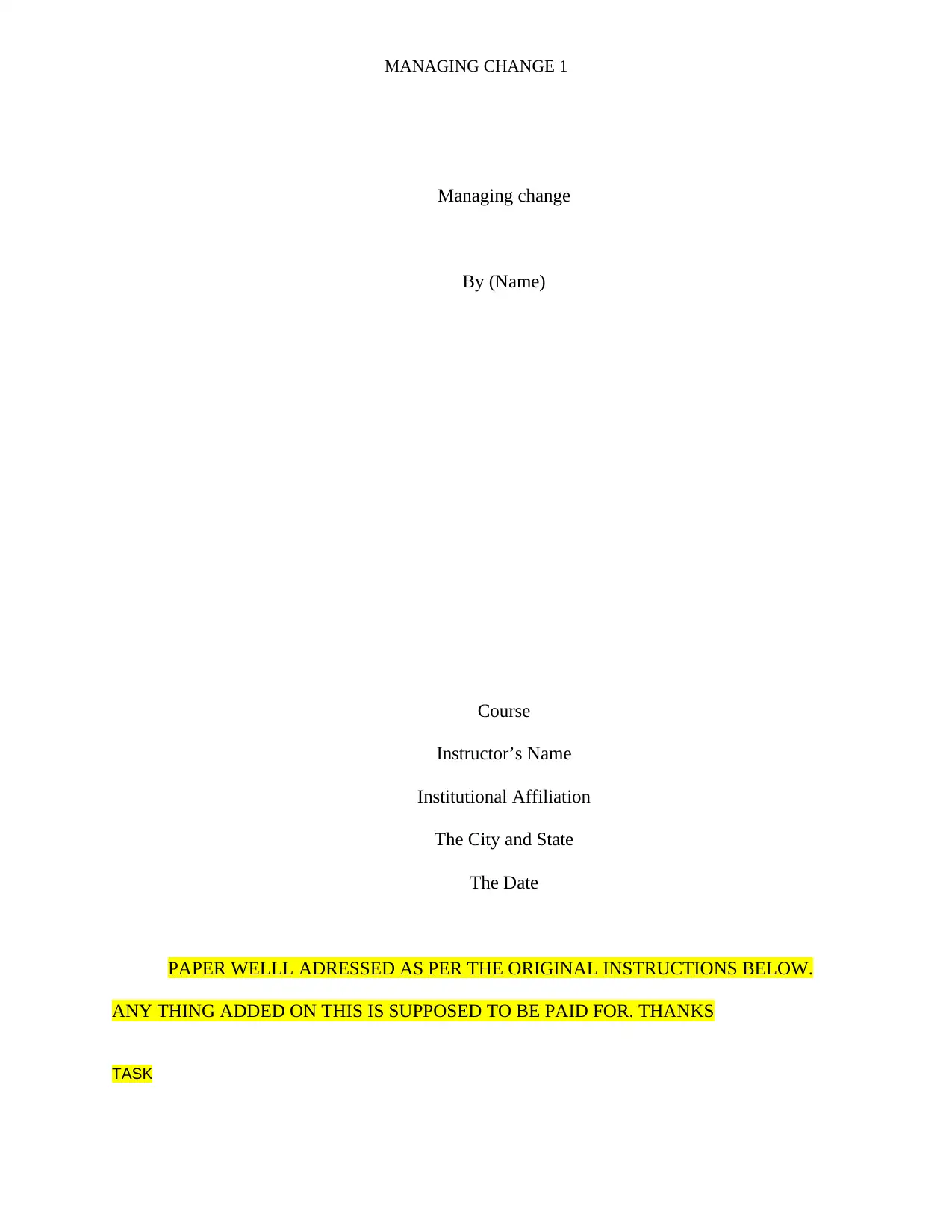
MANAGING CHANGE 1
Managing change
By (Name)
Course
Instructor’s Name
Institutional Affiliation
The City and State
The Date
PAPER WELLL ADRESSED AS PER THE ORIGINAL INSTRUCTIONS BELOW.
ANY THING ADDED ON THIS IS SUPPOSED TO BE PAID FOR. THANKS
TASK
Managing change
By (Name)
Course
Instructor’s Name
Institutional Affiliation
The City and State
The Date
PAPER WELLL ADRESSED AS PER THE ORIGINAL INSTRUCTIONS BELOW.
ANY THING ADDED ON THIS IS SUPPOSED TO BE PAID FOR. THANKS
TASK
Paraphrase This Document
Need a fresh take? Get an instant paraphrase of this document with our AI Paraphraser
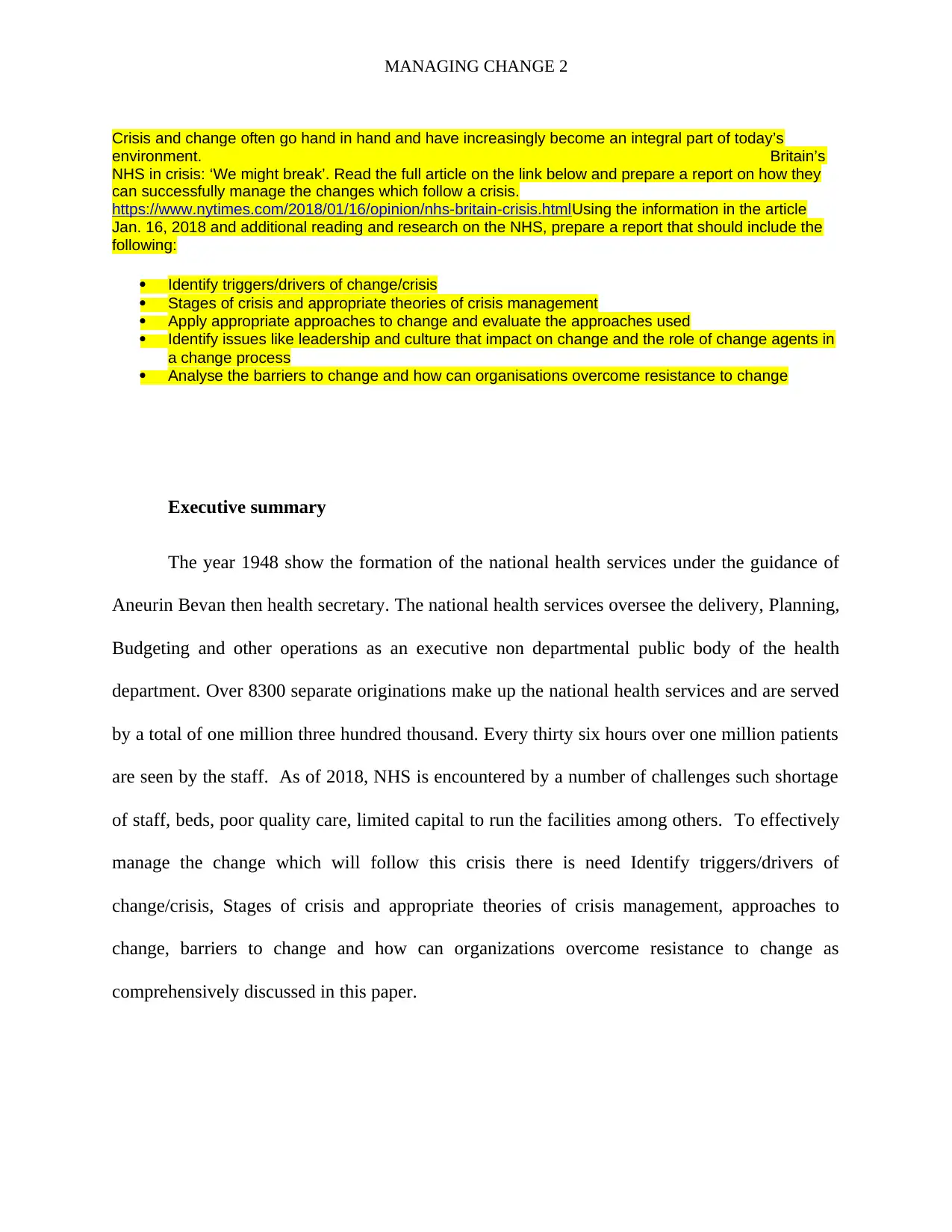
MANAGING CHANGE 2
Crisis and change often go hand in hand and have increasingly become an integral part of today’s
environment. Britain’s
NHS in crisis: ‘We might break’. Read the full article on the link below and prepare a report on how they
can successfully manage the changes which follow a crisis.
https://www.nytimes.com/2018/01/16/opinion/nhs-britain-crisis.htmlUsing the information in the article
Jan. 16, 2018 and additional reading and research on the NHS, prepare a report that should include the
following:
Identify triggers/drivers of change/crisis
Stages of crisis and appropriate theories of crisis management
Apply appropriate approaches to change and evaluate the approaches used
Identify issues like leadership and culture that impact on change and the role of change agents in
a change process
Analyse the barriers to change and how can organisations overcome resistance to change
Executive summary
The year 1948 show the formation of the national health services under the guidance of
Aneurin Bevan then health secretary. The national health services oversee the delivery, Planning,
Budgeting and other operations as an executive non departmental public body of the health
department. Over 8300 separate originations make up the national health services and are served
by a total of one million three hundred thousand. Every thirty six hours over one million patients
are seen by the staff. As of 2018, NHS is encountered by a number of challenges such shortage
of staff, beds, poor quality care, limited capital to run the facilities among others. To effectively
manage the change which will follow this crisis there is need Identify triggers/drivers of
change/crisis, Stages of crisis and appropriate theories of crisis management, approaches to
change, barriers to change and how can organizations overcome resistance to change as
comprehensively discussed in this paper.
Crisis and change often go hand in hand and have increasingly become an integral part of today’s
environment. Britain’s
NHS in crisis: ‘We might break’. Read the full article on the link below and prepare a report on how they
can successfully manage the changes which follow a crisis.
https://www.nytimes.com/2018/01/16/opinion/nhs-britain-crisis.htmlUsing the information in the article
Jan. 16, 2018 and additional reading and research on the NHS, prepare a report that should include the
following:
Identify triggers/drivers of change/crisis
Stages of crisis and appropriate theories of crisis management
Apply appropriate approaches to change and evaluate the approaches used
Identify issues like leadership and culture that impact on change and the role of change agents in
a change process
Analyse the barriers to change and how can organisations overcome resistance to change
Executive summary
The year 1948 show the formation of the national health services under the guidance of
Aneurin Bevan then health secretary. The national health services oversee the delivery, Planning,
Budgeting and other operations as an executive non departmental public body of the health
department. Over 8300 separate originations make up the national health services and are served
by a total of one million three hundred thousand. Every thirty six hours over one million patients
are seen by the staff. As of 2018, NHS is encountered by a number of challenges such shortage
of staff, beds, poor quality care, limited capital to run the facilities among others. To effectively
manage the change which will follow this crisis there is need Identify triggers/drivers of
change/crisis, Stages of crisis and appropriate theories of crisis management, approaches to
change, barriers to change and how can organizations overcome resistance to change as
comprehensively discussed in this paper.
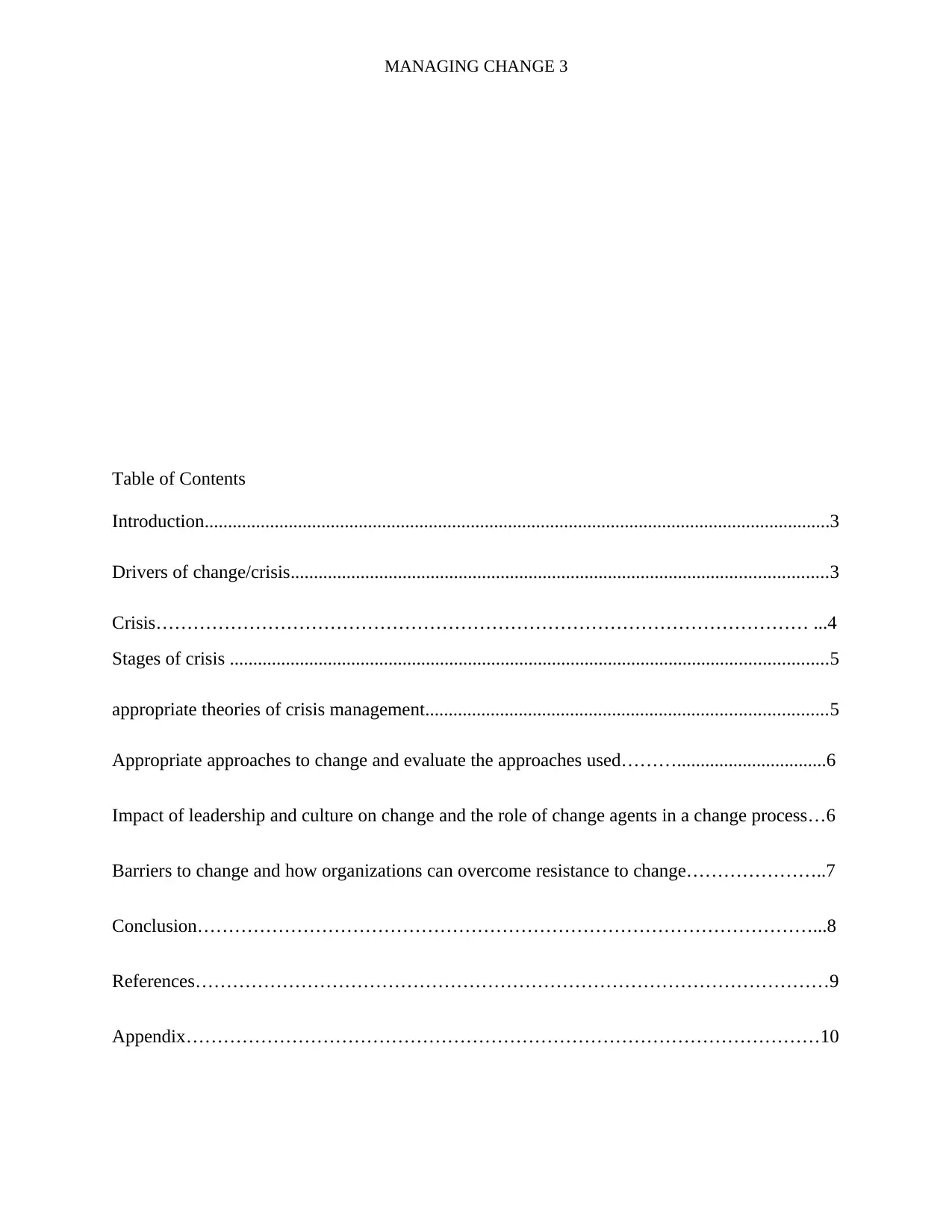
MANAGING CHANGE 3
Table of Contents
Introduction......................................................................................................................................3
Drivers of change/crisis...................................................................................................................3
Crisis…………………………………………………………………………………………… ...4
Stages of crisis ................................................................................................................................5
appropriate theories of crisis management......................................................................................5
Appropriate approaches to change and evaluate the approaches used………................................6
Impact of leadership and culture on change and the role of change agents in a change process…6
Barriers to change and how organizations can overcome resistance to change…………………..7
Conclusion………………………………………………………………………………………...8
References…………………………………………………………………………………………9
Appendix…………………………………………………………………………………………10
Table of Contents
Introduction......................................................................................................................................3
Drivers of change/crisis...................................................................................................................3
Crisis…………………………………………………………………………………………… ...4
Stages of crisis ................................................................................................................................5
appropriate theories of crisis management......................................................................................5
Appropriate approaches to change and evaluate the approaches used………................................6
Impact of leadership and culture on change and the role of change agents in a change process…6
Barriers to change and how organizations can overcome resistance to change…………………..7
Conclusion………………………………………………………………………………………...8
References…………………………………………………………………………………………9
Appendix…………………………………………………………………………………………10
⊘ This is a preview!⊘
Do you want full access?
Subscribe today to unlock all pages.

Trusted by 1+ million students worldwide
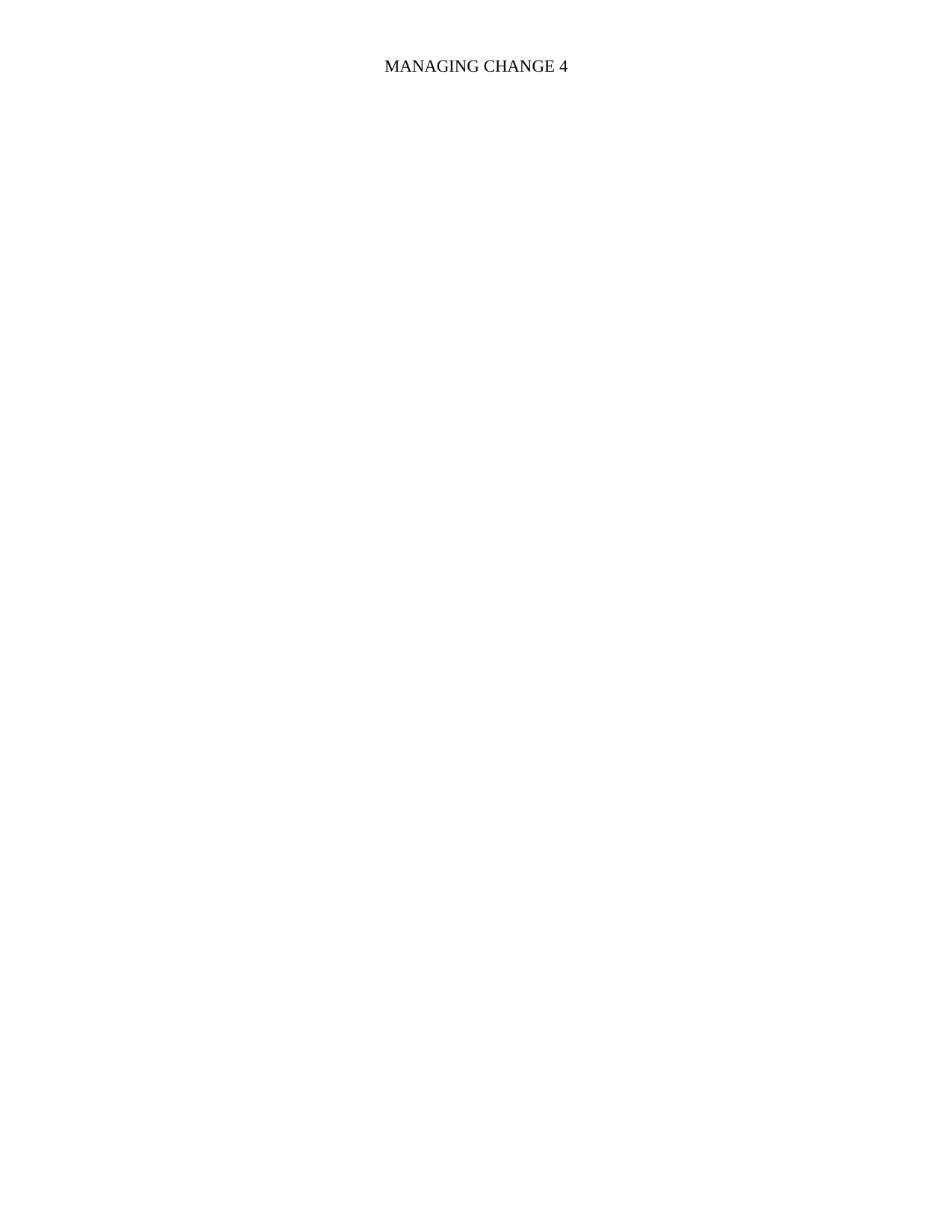
MANAGING CHANGE 4
Paraphrase This Document
Need a fresh take? Get an instant paraphrase of this document with our AI Paraphraser
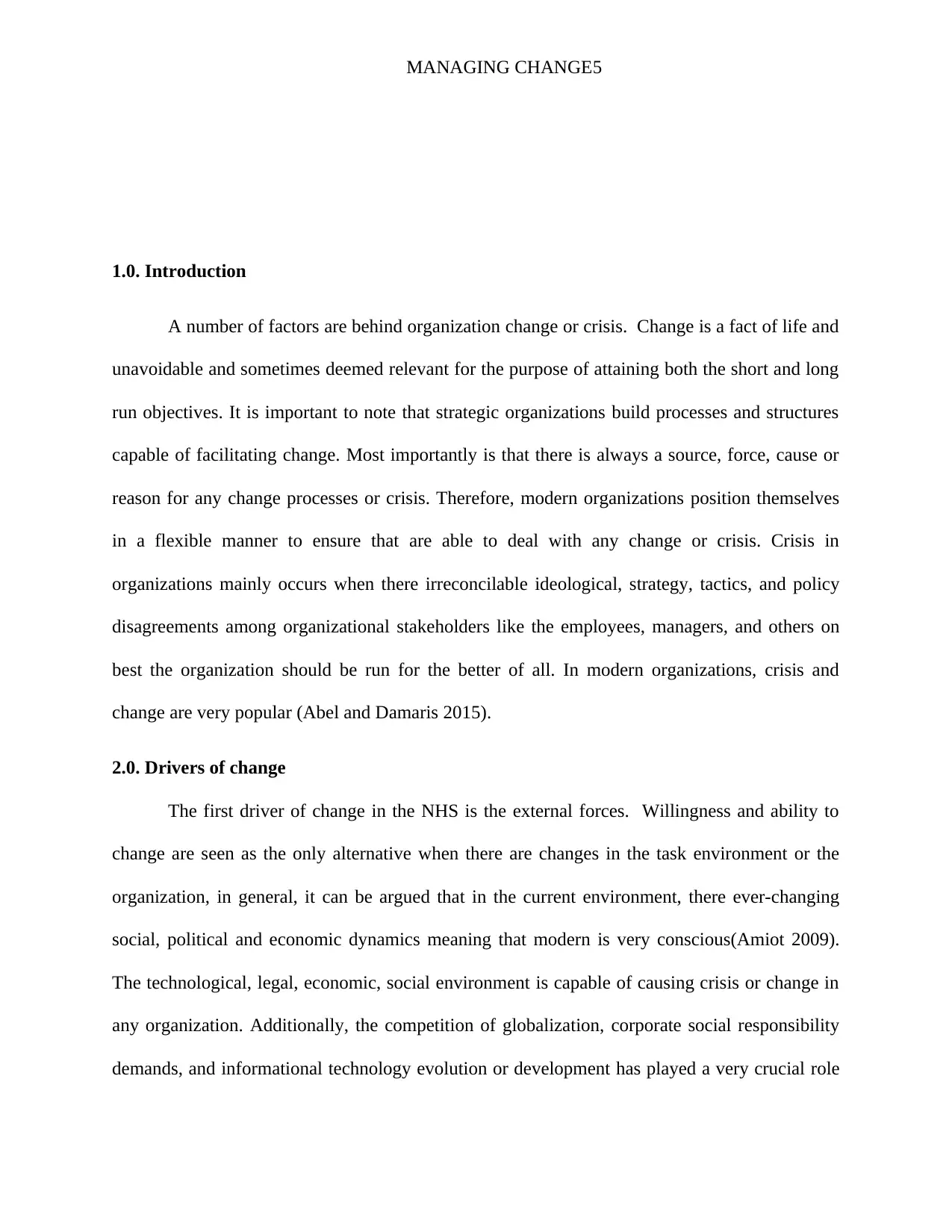
MANAGING CHANGE5
1.0. Introduction
A number of factors are behind organization change or crisis. Change is a fact of life and
unavoidable and sometimes deemed relevant for the purpose of attaining both the short and long
run objectives. It is important to note that strategic organizations build processes and structures
capable of facilitating change. Most importantly is that there is always a source, force, cause or
reason for any change processes or crisis. Therefore, modern organizations position themselves
in a flexible manner to ensure that are able to deal with any change or crisis. Crisis in
organizations mainly occurs when there irreconcilable ideological, strategy, tactics, and policy
disagreements among organizational stakeholders like the employees, managers, and others on
best the organization should be run for the better of all. In modern organizations, crisis and
change are very popular (Abel and Damaris 2015).
2.0. Drivers of change
The first driver of change in the NHS is the external forces. Willingness and ability to
change are seen as the only alternative when there are changes in the task environment or the
organization, in general, it can be argued that in the current environment, there ever-changing
social, political and economic dynamics meaning that modern is very conscious(Amiot 2009).
The technological, legal, economic, social environment is capable of causing crisis or change in
any organization. Additionally, the competition of globalization, corporate social responsibility
demands, and informational technology evolution or development has played a very crucial role
1.0. Introduction
A number of factors are behind organization change or crisis. Change is a fact of life and
unavoidable and sometimes deemed relevant for the purpose of attaining both the short and long
run objectives. It is important to note that strategic organizations build processes and structures
capable of facilitating change. Most importantly is that there is always a source, force, cause or
reason for any change processes or crisis. Therefore, modern organizations position themselves
in a flexible manner to ensure that are able to deal with any change or crisis. Crisis in
organizations mainly occurs when there irreconcilable ideological, strategy, tactics, and policy
disagreements among organizational stakeholders like the employees, managers, and others on
best the organization should be run for the better of all. In modern organizations, crisis and
change are very popular (Abel and Damaris 2015).
2.0. Drivers of change
The first driver of change in the NHS is the external forces. Willingness and ability to
change are seen as the only alternative when there are changes in the task environment or the
organization, in general, it can be argued that in the current environment, there ever-changing
social, political and economic dynamics meaning that modern is very conscious(Amiot 2009).
The technological, legal, economic, social environment is capable of causing crisis or change in
any organization. Additionally, the competition of globalization, corporate social responsibility
demands, and informational technology evolution or development has played a very crucial role
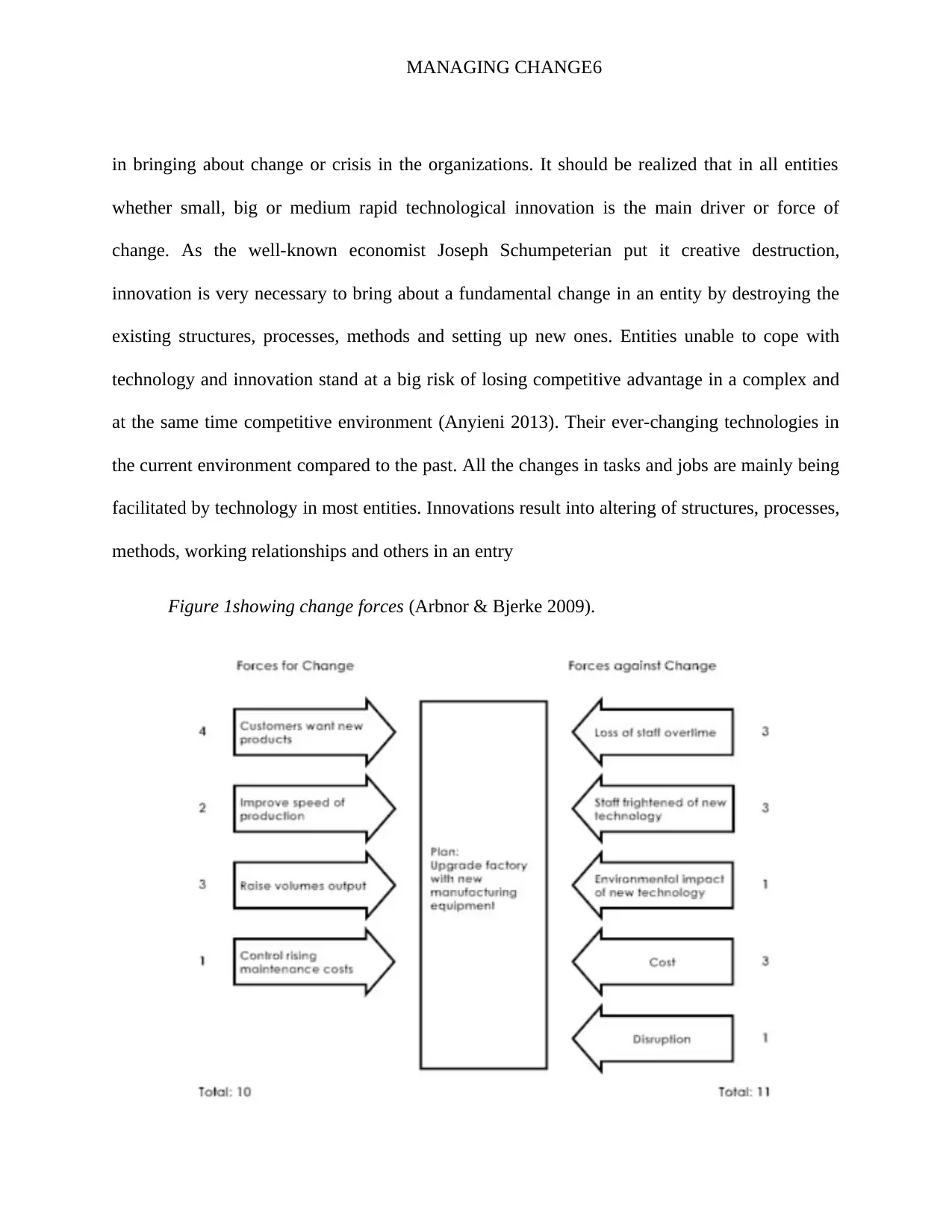
MANAGING CHANGE6
in bringing about change or crisis in the organizations. It should be realized that in all entities
whether small, big or medium rapid technological innovation is the main driver or force of
change. As the well-known economist Joseph Schumpeterian put it creative destruction,
innovation is very necessary to bring about a fundamental change in an entity by destroying the
existing structures, processes, methods and setting up new ones. Entities unable to cope with
technology and innovation stand at a big risk of losing competitive advantage in a complex and
at the same time competitive environment (Anyieni 2013). Their ever-changing technologies in
the current environment compared to the past. All the changes in tasks and jobs are mainly being
facilitated by technology in most entities. Innovations result into altering of structures, processes,
methods, working relationships and others in an entry
Figure 1showing change forces (Arbnor & Bjerke 2009).
in bringing about change or crisis in the organizations. It should be realized that in all entities
whether small, big or medium rapid technological innovation is the main driver or force of
change. As the well-known economist Joseph Schumpeterian put it creative destruction,
innovation is very necessary to bring about a fundamental change in an entity by destroying the
existing structures, processes, methods and setting up new ones. Entities unable to cope with
technology and innovation stand at a big risk of losing competitive advantage in a complex and
at the same time competitive environment (Anyieni 2013). Their ever-changing technologies in
the current environment compared to the past. All the changes in tasks and jobs are mainly being
facilitated by technology in most entities. Innovations result into altering of structures, processes,
methods, working relationships and others in an entry
Figure 1showing change forces (Arbnor & Bjerke 2009).
⊘ This is a preview!⊘
Do you want full access?
Subscribe today to unlock all pages.

Trusted by 1+ million students worldwide
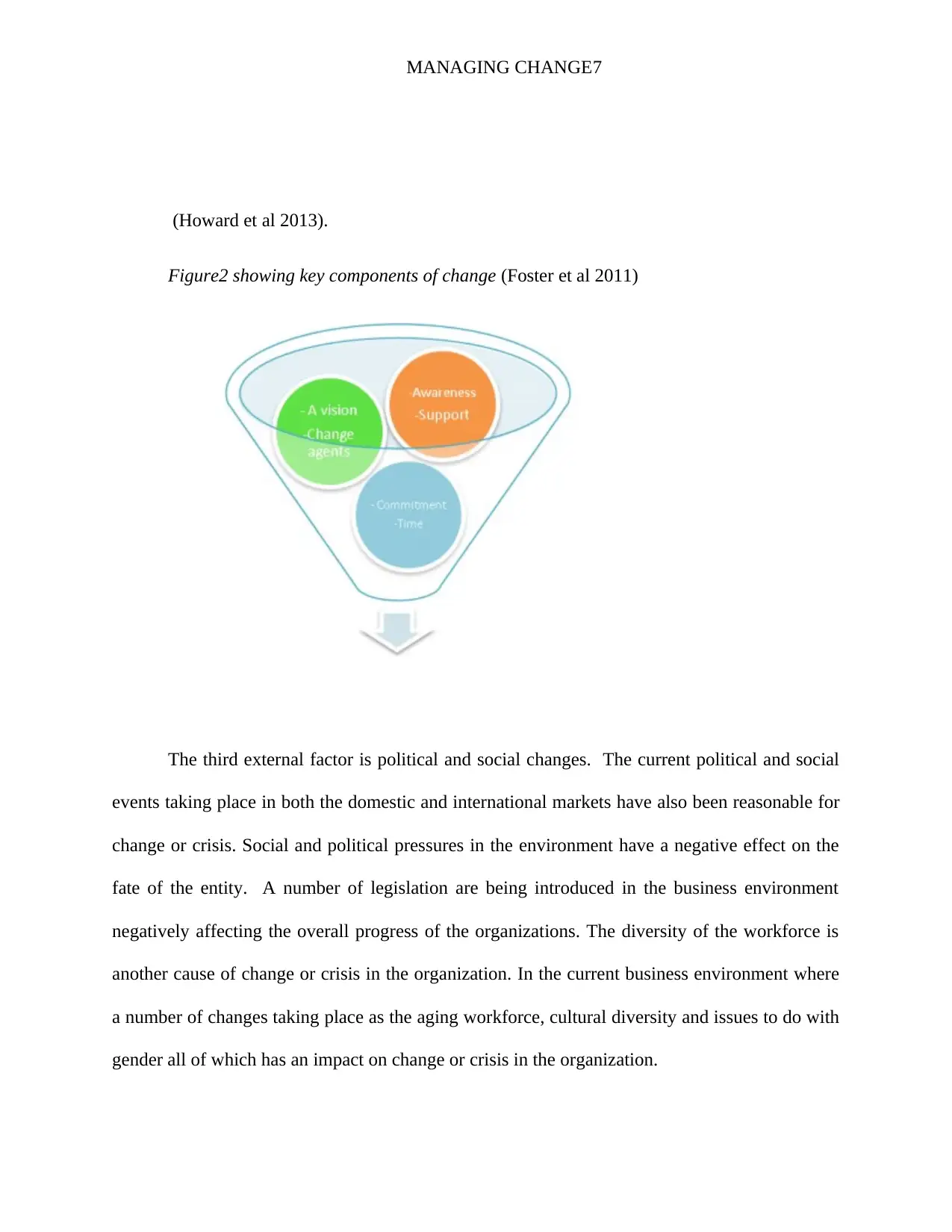
MANAGING CHANGE7
(Howard et al 2013).
Figure2 showing key components of change (Foster et al 2011)
The third external factor is political and social changes. The current political and social
events taking place in both the domestic and international markets have also been reasonable for
change or crisis. Social and political pressures in the environment have a negative effect on the
fate of the entity. A number of legislation are being introduced in the business environment
negatively affecting the overall progress of the organizations. The diversity of the workforce is
another cause of change or crisis in the organization. In the current business environment where
a number of changes taking place as the aging workforce, cultural diversity and issues to do with
gender all of which has an impact on change or crisis in the organization.
(Howard et al 2013).
Figure2 showing key components of change (Foster et al 2011)
The third external factor is political and social changes. The current political and social
events taking place in both the domestic and international markets have also been reasonable for
change or crisis. Social and political pressures in the environment have a negative effect on the
fate of the entity. A number of legislation are being introduced in the business environment
negatively affecting the overall progress of the organizations. The diversity of the workforce is
another cause of change or crisis in the organization. In the current business environment where
a number of changes taking place as the aging workforce, cultural diversity and issues to do with
gender all of which has an impact on change or crisis in the organization.
Paraphrase This Document
Need a fresh take? Get an instant paraphrase of this document with our AI Paraphraser
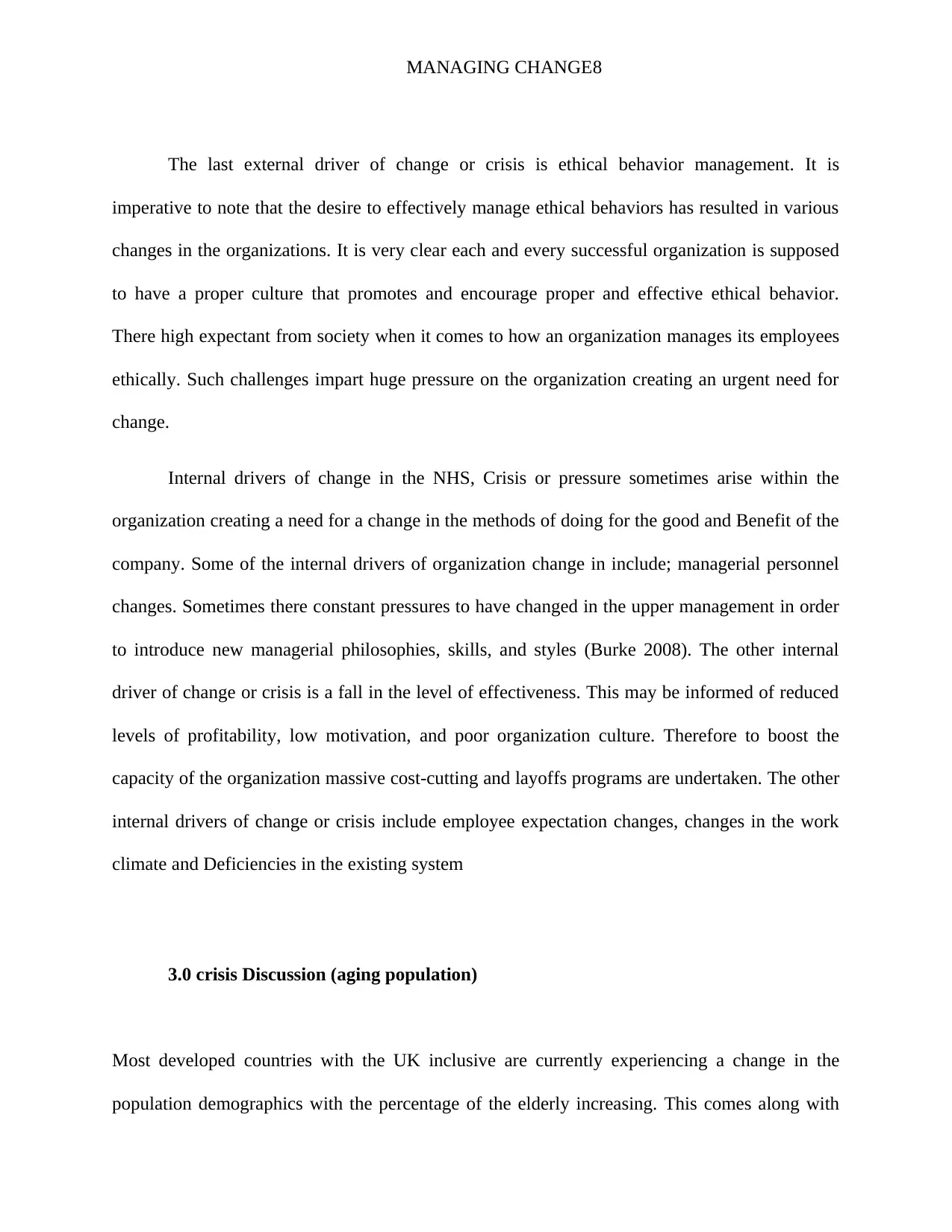
MANAGING CHANGE8
The last external driver of change or crisis is ethical behavior management. It is
imperative to note that the desire to effectively manage ethical behaviors has resulted in various
changes in the organizations. It is very clear each and every successful organization is supposed
to have a proper culture that promotes and encourage proper and effective ethical behavior.
There high expectant from society when it comes to how an organization manages its employees
ethically. Such challenges impart huge pressure on the organization creating an urgent need for
change.
Internal drivers of change in the NHS, Crisis or pressure sometimes arise within the
organization creating a need for a change in the methods of doing for the good and Benefit of the
company. Some of the internal drivers of organization change in include; managerial personnel
changes. Sometimes there constant pressures to have changed in the upper management in order
to introduce new managerial philosophies, skills, and styles (Burke 2008). The other internal
driver of change or crisis is a fall in the level of effectiveness. This may be informed of reduced
levels of profitability, low motivation, and poor organization culture. Therefore to boost the
capacity of the organization massive cost-cutting and layoffs programs are undertaken. The other
internal drivers of change or crisis include employee expectation changes, changes in the work
climate and Deficiencies in the existing system
3.0 crisis Discussion (aging population)
Most developed countries with the UK inclusive are currently experiencing a change in the
population demographics with the percentage of the elderly increasing. This comes along with
The last external driver of change or crisis is ethical behavior management. It is
imperative to note that the desire to effectively manage ethical behaviors has resulted in various
changes in the organizations. It is very clear each and every successful organization is supposed
to have a proper culture that promotes and encourage proper and effective ethical behavior.
There high expectant from society when it comes to how an organization manages its employees
ethically. Such challenges impart huge pressure on the organization creating an urgent need for
change.
Internal drivers of change in the NHS, Crisis or pressure sometimes arise within the
organization creating a need for a change in the methods of doing for the good and Benefit of the
company. Some of the internal drivers of organization change in include; managerial personnel
changes. Sometimes there constant pressures to have changed in the upper management in order
to introduce new managerial philosophies, skills, and styles (Burke 2008). The other internal
driver of change or crisis is a fall in the level of effectiveness. This may be informed of reduced
levels of profitability, low motivation, and poor organization culture. Therefore to boost the
capacity of the organization massive cost-cutting and layoffs programs are undertaken. The other
internal drivers of change or crisis include employee expectation changes, changes in the work
climate and Deficiencies in the existing system
3.0 crisis Discussion (aging population)
Most developed countries with the UK inclusive are currently experiencing a change in the
population demographics with the percentage of the elderly increasing. This comes along with
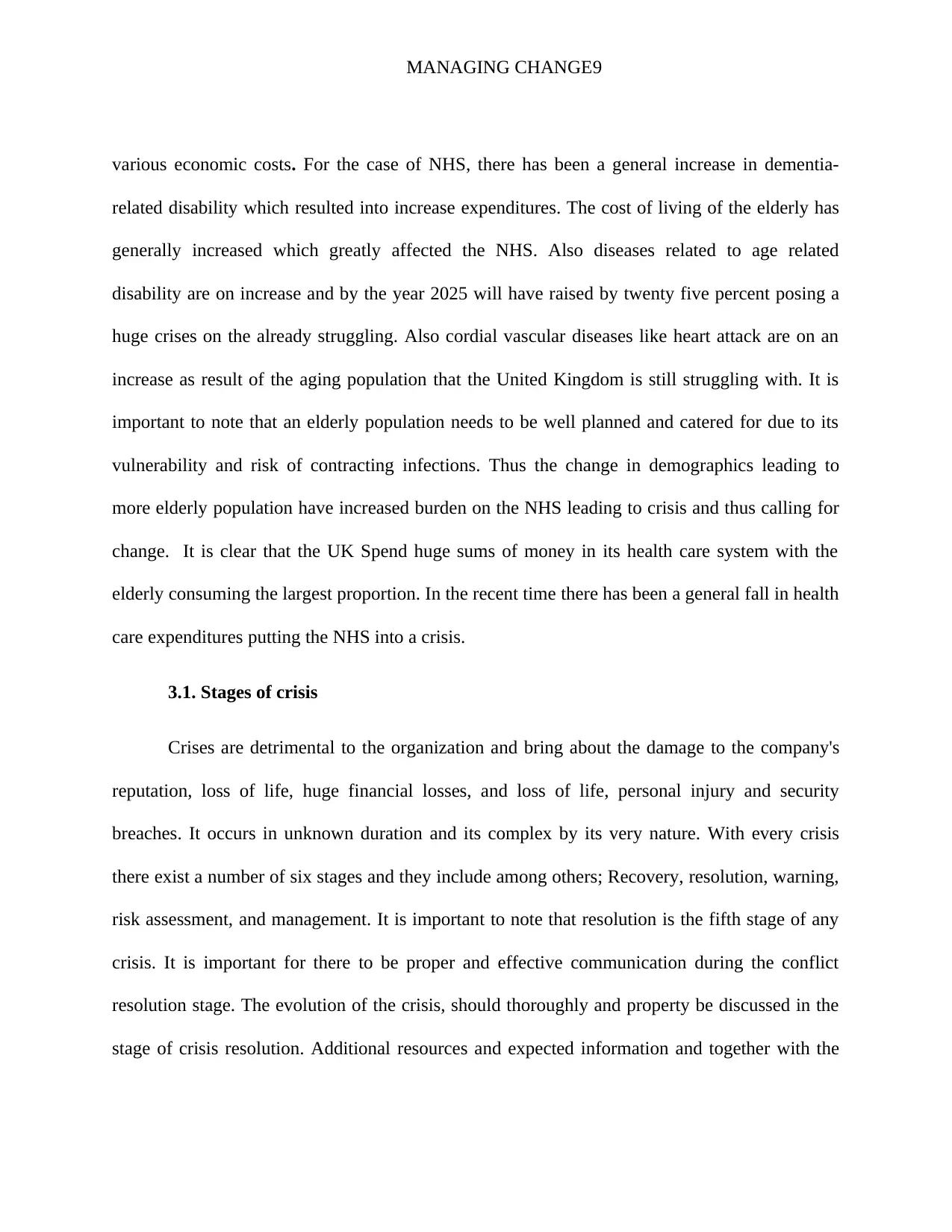
MANAGING CHANGE9
various economic costs. For the case of NHS, there has been a general increase in dementia-
related disability which resulted into increase expenditures. The cost of living of the elderly has
generally increased which greatly affected the NHS. Also diseases related to age related
disability are on increase and by the year 2025 will have raised by twenty five percent posing a
huge crises on the already struggling. Also cordial vascular diseases like heart attack are on an
increase as result of the aging population that the United Kingdom is still struggling with. It is
important to note that an elderly population needs to be well planned and catered for due to its
vulnerability and risk of contracting infections. Thus the change in demographics leading to
more elderly population have increased burden on the NHS leading to crisis and thus calling for
change. It is clear that the UK Spend huge sums of money in its health care system with the
elderly consuming the largest proportion. In the recent time there has been a general fall in health
care expenditures putting the NHS into a crisis.
3.1. Stages of crisis
Crises are detrimental to the organization and bring about the damage to the company's
reputation, loss of life, huge financial losses, and loss of life, personal injury and security
breaches. It occurs in unknown duration and its complex by its very nature. With every crisis
there exist a number of six stages and they include among others; Recovery, resolution, warning,
risk assessment, and management. It is important to note that resolution is the fifth stage of any
crisis. It is important for there to be proper and effective communication during the conflict
resolution stage. The evolution of the crisis, should thoroughly and property be discussed in the
stage of crisis resolution. Additional resources and expected information and together with the
various economic costs. For the case of NHS, there has been a general increase in dementia-
related disability which resulted into increase expenditures. The cost of living of the elderly has
generally increased which greatly affected the NHS. Also diseases related to age related
disability are on increase and by the year 2025 will have raised by twenty five percent posing a
huge crises on the already struggling. Also cordial vascular diseases like heart attack are on an
increase as result of the aging population that the United Kingdom is still struggling with. It is
important to note that an elderly population needs to be well planned and catered for due to its
vulnerability and risk of contracting infections. Thus the change in demographics leading to
more elderly population have increased burden on the NHS leading to crisis and thus calling for
change. It is clear that the UK Spend huge sums of money in its health care system with the
elderly consuming the largest proportion. In the recent time there has been a general fall in health
care expenditures putting the NHS into a crisis.
3.1. Stages of crisis
Crises are detrimental to the organization and bring about the damage to the company's
reputation, loss of life, huge financial losses, and loss of life, personal injury and security
breaches. It occurs in unknown duration and its complex by its very nature. With every crisis
there exist a number of six stages and they include among others; Recovery, resolution, warning,
risk assessment, and management. It is important to note that resolution is the fifth stage of any
crisis. It is important for there to be proper and effective communication during the conflict
resolution stage. The evolution of the crisis, should thoroughly and property be discussed in the
stage of crisis resolution. Additional resources and expected information and together with the
⊘ This is a preview!⊘
Do you want full access?
Subscribe today to unlock all pages.

Trusted by 1+ million students worldwide
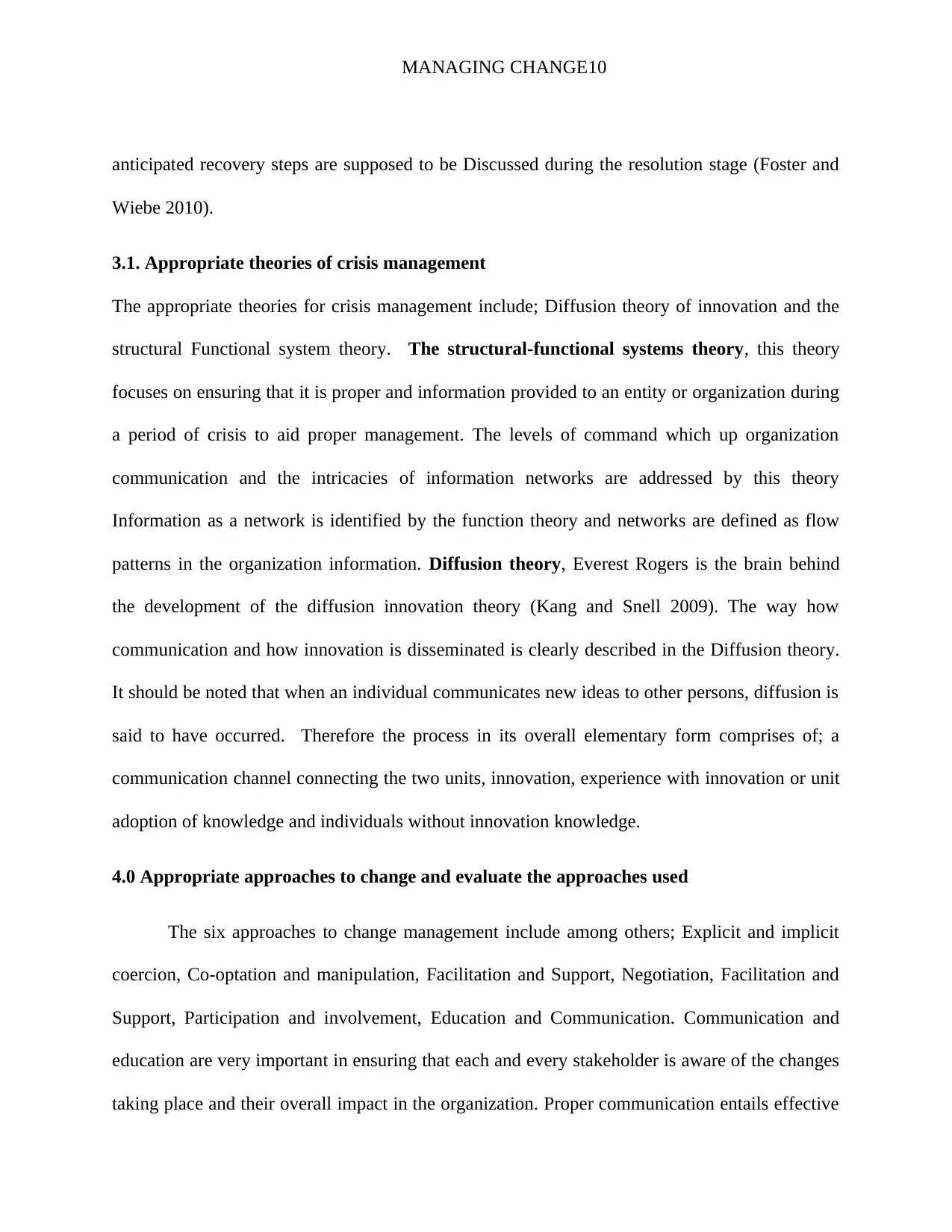
MANAGING CHANGE10
anticipated recovery steps are supposed to be Discussed during the resolution stage (Foster and
Wiebe 2010).
3.1. Appropriate theories of crisis management
The appropriate theories for crisis management include; Diffusion theory of innovation and the
structural Functional system theory. The structural-functional systems theory, this theory
focuses on ensuring that it is proper and information provided to an entity or organization during
a period of crisis to aid proper management. The levels of command which up organization
communication and the intricacies of information networks are addressed by this theory
Information as a network is identified by the function theory and networks are defined as flow
patterns in the organization information. Diffusion theory, Everest Rogers is the brain behind
the development of the diffusion innovation theory (Kang and Snell 2009). The way how
communication and how innovation is disseminated is clearly described in the Diffusion theory.
It should be noted that when an individual communicates new ideas to other persons, diffusion is
said to have occurred. Therefore the process in its overall elementary form comprises of; a
communication channel connecting the two units, innovation, experience with innovation or unit
adoption of knowledge and individuals without innovation knowledge.
4.0 Appropriate approaches to change and evaluate the approaches used
The six approaches to change management include among others; Explicit and implicit
coercion, Co-optation and manipulation, Facilitation and Support, Negotiation, Facilitation and
Support, Participation and involvement, Education and Communication. Communication and
education are very important in ensuring that each and every stakeholder is aware of the changes
taking place and their overall impact in the organization. Proper communication entails effective
anticipated recovery steps are supposed to be Discussed during the resolution stage (Foster and
Wiebe 2010).
3.1. Appropriate theories of crisis management
The appropriate theories for crisis management include; Diffusion theory of innovation and the
structural Functional system theory. The structural-functional systems theory, this theory
focuses on ensuring that it is proper and information provided to an entity or organization during
a period of crisis to aid proper management. The levels of command which up organization
communication and the intricacies of information networks are addressed by this theory
Information as a network is identified by the function theory and networks are defined as flow
patterns in the organization information. Diffusion theory, Everest Rogers is the brain behind
the development of the diffusion innovation theory (Kang and Snell 2009). The way how
communication and how innovation is disseminated is clearly described in the Diffusion theory.
It should be noted that when an individual communicates new ideas to other persons, diffusion is
said to have occurred. Therefore the process in its overall elementary form comprises of; a
communication channel connecting the two units, innovation, experience with innovation or unit
adoption of knowledge and individuals without innovation knowledge.
4.0 Appropriate approaches to change and evaluate the approaches used
The six approaches to change management include among others; Explicit and implicit
coercion, Co-optation and manipulation, Facilitation and Support, Negotiation, Facilitation and
Support, Participation and involvement, Education and Communication. Communication and
education are very important in ensuring that each and every stakeholder is aware of the changes
taking place and their overall impact in the organization. Proper communication entails effective
Paraphrase This Document
Need a fresh take? Get an instant paraphrase of this document with our AI Paraphraser
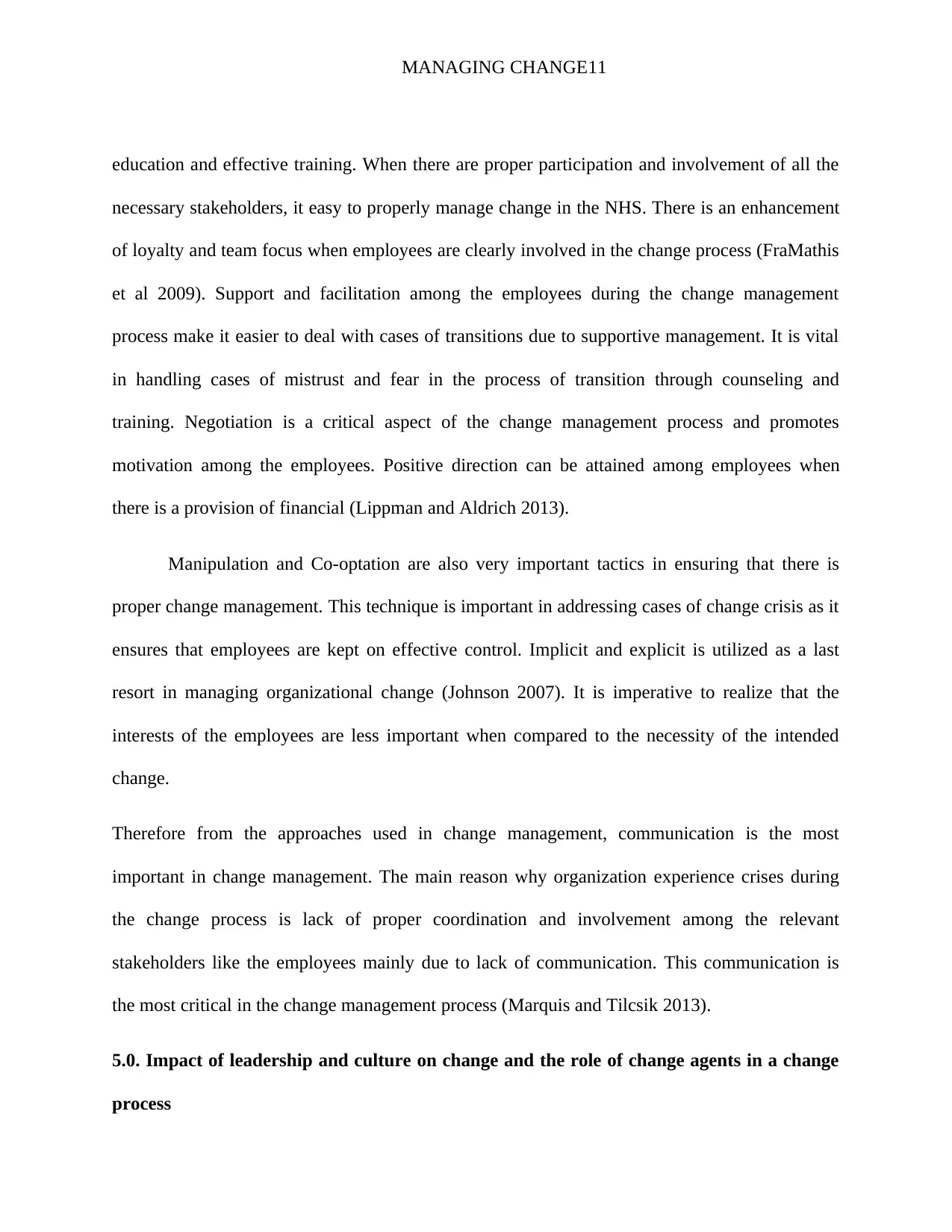
MANAGING CHANGE11
education and effective training. When there are proper participation and involvement of all the
necessary stakeholders, it easy to properly manage change in the NHS. There is an enhancement
of loyalty and team focus when employees are clearly involved in the change process (FraMathis
et al 2009). Support and facilitation among the employees during the change management
process make it easier to deal with cases of transitions due to supportive management. It is vital
in handling cases of mistrust and fear in the process of transition through counseling and
training. Negotiation is a critical aspect of the change management process and promotes
motivation among the employees. Positive direction can be attained among employees when
there is a provision of financial (Lippman and Aldrich 2013).
Manipulation and Co-optation are also very important tactics in ensuring that there is
proper change management. This technique is important in addressing cases of change crisis as it
ensures that employees are kept on effective control. Implicit and explicit is utilized as a last
resort in managing organizational change (Johnson 2007). It is imperative to realize that the
interests of the employees are less important when compared to the necessity of the intended
change.
Therefore from the approaches used in change management, communication is the most
important in change management. The main reason why organization experience crises during
the change process is lack of proper coordination and involvement among the relevant
stakeholders like the employees mainly due to lack of communication. This communication is
the most critical in the change management process (Marquis and Tilcsik 2013).
5.0. Impact of leadership and culture on change and the role of change agents in a change
process
education and effective training. When there are proper participation and involvement of all the
necessary stakeholders, it easy to properly manage change in the NHS. There is an enhancement
of loyalty and team focus when employees are clearly involved in the change process (FraMathis
et al 2009). Support and facilitation among the employees during the change management
process make it easier to deal with cases of transitions due to supportive management. It is vital
in handling cases of mistrust and fear in the process of transition through counseling and
training. Negotiation is a critical aspect of the change management process and promotes
motivation among the employees. Positive direction can be attained among employees when
there is a provision of financial (Lippman and Aldrich 2013).
Manipulation and Co-optation are also very important tactics in ensuring that there is
proper change management. This technique is important in addressing cases of change crisis as it
ensures that employees are kept on effective control. Implicit and explicit is utilized as a last
resort in managing organizational change (Johnson 2007). It is imperative to realize that the
interests of the employees are less important when compared to the necessity of the intended
change.
Therefore from the approaches used in change management, communication is the most
important in change management. The main reason why organization experience crises during
the change process is lack of proper coordination and involvement among the relevant
stakeholders like the employees mainly due to lack of communication. This communication is
the most critical in the change management process (Marquis and Tilcsik 2013).
5.0. Impact of leadership and culture on change and the role of change agents in a change
process
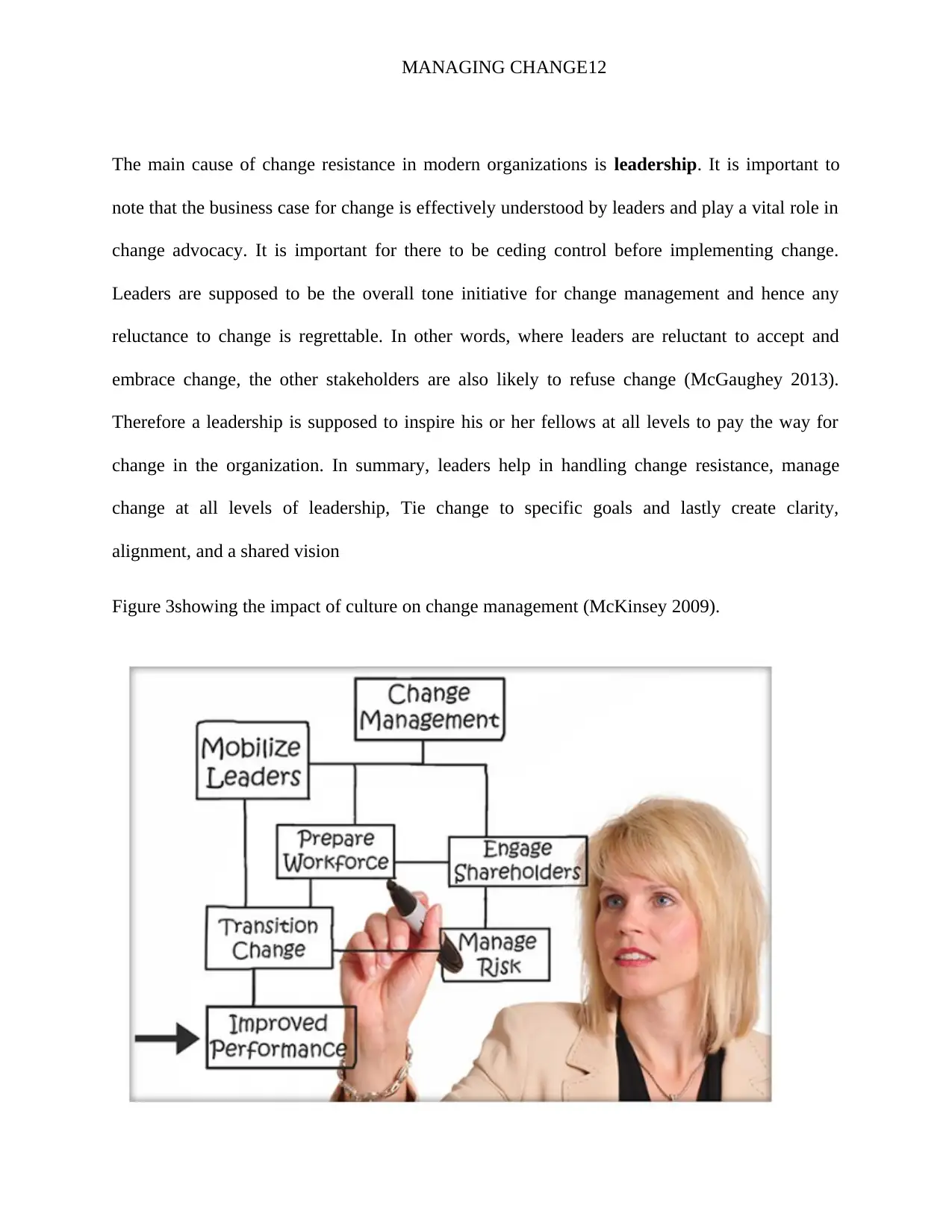
MANAGING CHANGE12
The main cause of change resistance in modern organizations is leadership. It is important to
note that the business case for change is effectively understood by leaders and play a vital role in
change advocacy. It is important for there to be ceding control before implementing change.
Leaders are supposed to be the overall tone initiative for change management and hence any
reluctance to change is regrettable. In other words, where leaders are reluctant to accept and
embrace change, the other stakeholders are also likely to refuse change (McGaughey 2013).
Therefore a leadership is supposed to inspire his or her fellows at all levels to pay the way for
change in the organization. In summary, leaders help in handling change resistance, manage
change at all levels of leadership, Tie change to specific goals and lastly create clarity,
alignment, and a shared vision
Figure 3showing the impact of culture on change management (McKinsey 2009).
The main cause of change resistance in modern organizations is leadership. It is important to
note that the business case for change is effectively understood by leaders and play a vital role in
change advocacy. It is important for there to be ceding control before implementing change.
Leaders are supposed to be the overall tone initiative for change management and hence any
reluctance to change is regrettable. In other words, where leaders are reluctant to accept and
embrace change, the other stakeholders are also likely to refuse change (McGaughey 2013).
Therefore a leadership is supposed to inspire his or her fellows at all levels to pay the way for
change in the organization. In summary, leaders help in handling change resistance, manage
change at all levels of leadership, Tie change to specific goals and lastly create clarity,
alignment, and a shared vision
Figure 3showing the impact of culture on change management (McKinsey 2009).
⊘ This is a preview!⊘
Do you want full access?
Subscribe today to unlock all pages.

Trusted by 1+ million students worldwide
1 out of 18
Related Documents
Your All-in-One AI-Powered Toolkit for Academic Success.
+13062052269
info@desklib.com
Available 24*7 on WhatsApp / Email
![[object Object]](/_next/static/media/star-bottom.7253800d.svg)
Unlock your academic potential
Copyright © 2020–2025 A2Z Services. All Rights Reserved. Developed and managed by ZUCOL.



